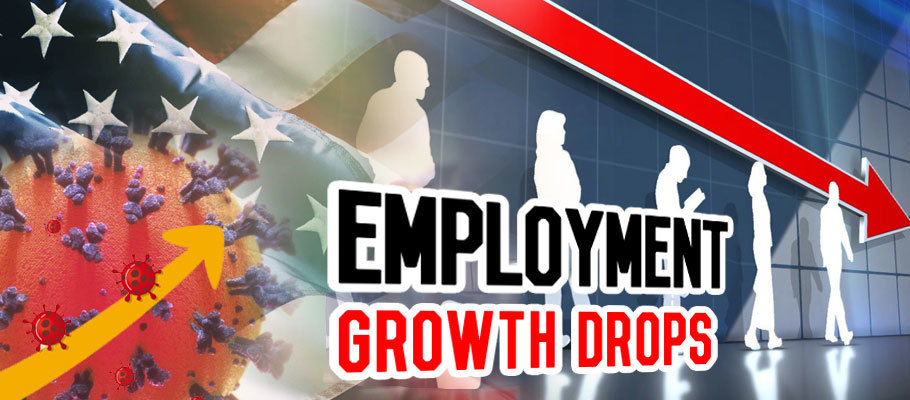
Published: December 8th, 2020
Nonfarm payrolls rose by some 250,000 against the expected 440,000 jobs. The number is down from 610,000 recorded in October. However, unemployment decreased overall to 6.7%, just within Wall Street's estimates. Despite the slim margins, unemployment rates are still high because of the increasing new infections of coronavirus.
According to the data published by the U.S.'s Bureau of Labor Statistics on Friday, November 4, the Nonfarm Payrolls (NFP) rose by 245,000 this month. The reading is a dismal performance compared to October's 610,000 jobs. The NFP figure fell significantly below the market expectations of 469,000.
Details of the bureau's report show that the overall unemployment rate fell to 6.7%, up from 6.9% the month before. The Labor Force Participation Rate also slipped by 0.2% to 61.5%. However, the NFP data did not come anywhere close to the forecast.
Job gains were recorded mostly in warehousing, professional, and business services. However, retail fell ahead of the nation's holiday shopping season as the pandemic's spread pushed most people to complete their shopping online.
Market experts opine that the surge in new coronavirus infections has led to a considerable decrease in hiring. The Dow Jones surveyed economists who forecasted the NFP numbers to stand around 440,000 for November, with the jobless rate dropping from 6.9% recorded in October to 6.7% in November.
The number of Americans that remain out of the labor force now stands at slightly over 10 million. Overall, the economy has scrapped back 12.3 million of the 22 million jobs washed away in the first two months of the coronavirus pandemic.
The initial market reaction to the NFP data pushed the greenback lower. The dollar lost 0.2% just moments after the news to stand at 90.53. Away from the markets, several metrics in the job markets shifted only ever so slightly.
For instance, the employment-population ratio changed marginally over November, standing at 57.3%. However, the figure is still 3.8% lower than it was in February. The November average hourly earnings for employees in NFP increased by almost 10% to stand at $29.58. However, the average workweek for these employees remained unchanged for November at 34.8 hours. The markets also moved just slightly, with Wall Street opening higher.
Despite the increase in NFP numbers, the timing is unfortunate. A surge of 245,000 positions would have been phenomenal and robust in pre-pandemic times. However, the same numbers, concerning November 2020, coming when millions have lost their jobs, only represent a modest recovery at best.
According to Daniel Zhao, a lead data scientist and senior economist at Glassdoor, a job placement service, if the economy proceeds with the pace witnessed in November, it may not be until 2024 before pre-pandemic conditions are attained.
Zhao added that Friday, November 4's job reports are a stark reminder that the economy is not out of the woods yet. Even with a vaccine's prospects, many people are getting ready for a long winter ahead, the economist added.
The November figure represents the slowest growth rate since employment recovery resumed in May. The number of workers who remained unemployed for the past 25 weeks has increased by 11% to stand at almost 4 Million.
Economists at Jeffries concurred that the comprehensive report is disappointing. In their note to clients, the economists said that with the surging cases of coronavirus infections and policies coming up to try and stem the tide, hiring has considerably slowed down.
Besides, worker availability is raising concern. Many eligible workers are not available to work because of the pandemic concerns and family care obligations, the note added.
Most of the gains came from the transportation and warehousing sector, with some 145,000 jobs recorded. These jobs arose mainly because of an increase in messengers and couriers as well as storage and warehousing.
Business and professional services brought in 66,000 jobs, while healthcare positions rose by 46,000. The hospitality industry, which has suffered the worst of the pandemic and accounts for the most job losses, brought back only 31,000 jobs.
The retail sector lost some 35,000 jobs, a likely distressing sign as the country steps into the holiday shopping season. General merchandise stores lost the most significant chunk, dropping some 21,000 jobs. Hobby, books, sporting goods, and music stores shed 12,000 jobs while personal, and healthcare stores cut 8,000 jobs.
Electronics and appliances shops lost 11,000 jobs. Overall, the retail sector is less some 550,000 jobs than February, a month before authorities enforced pandemic restrictions.
The manufacturing and construction sectors contributed 27,000 new jobs for November, while financial activities created 15,000 jobs. Government hiring declined for the third consecutive month, sliding almost 100,000 because of employee attrition, funding shortfalls, and litigation affecting the 2020 population count.
The dismal jobs data came amid a new relentless increase in coronavirus cases that threaten to shove the U.S. healthcare system into the doldrums. More than 100,000 patients are hospitalized in the country as a result of the fresh outbreak.
According to the Atlantic's COVID Tracing Project, the U.S. experienced a record-breaking 210,163 new cases on Thursday, November 3.
Despite the gloom, America is coming off what is easily the fastest growth quarter ever. However, economists are worried that the next quarter or two could come with flat or even negative growth. Luckily, almost all surveyed economists agreed that a thunderous rebound is more than likely in the second half of 2021 onwards.
According to the data released by the U.S. Bureau of Labor Statistics, the country had only 245,000 new nonfarm payroll jobs in November. It is a stark difference from the 440,000 that Wall Street predicted. The steep decline in employment growth is blamed on the surging coronavirus infections. The country has recorded more than 1 million new cases in the past five days alone, and hospitalization is now at an all-time high.